Rural Economy and Growth: Analyzing Importance, Planning, and Policies
VerifiedAdded on 2020/04/15
|14
|3899
|38
Report
AI Summary
This report delves into the critical role of the rural economy in fostering overall economic growth and sustainable development. It begins by defining rural areas and explaining the rationale behind a rural growth agenda, emphasizing the shift from traditional agricultural-focused planning to a more inclusive approach that considers various aspects of rural life. The report then highlights the importance of the rural economy, discussing its impact on life quality, social harmony, and regional economies. It further examines the roles of planning in facilitating development, including optimizing economic growth, ensuring balanced development, and acting as a reflector for societal needs. The analysis extends to urban-rural development planning, exploring smart growth ideas and cooperative strategies. The report concludes by underscoring the necessity of strong rural economy development for a robust national economy and a long-term sustainable model, supported by various policies and planning initiatives.
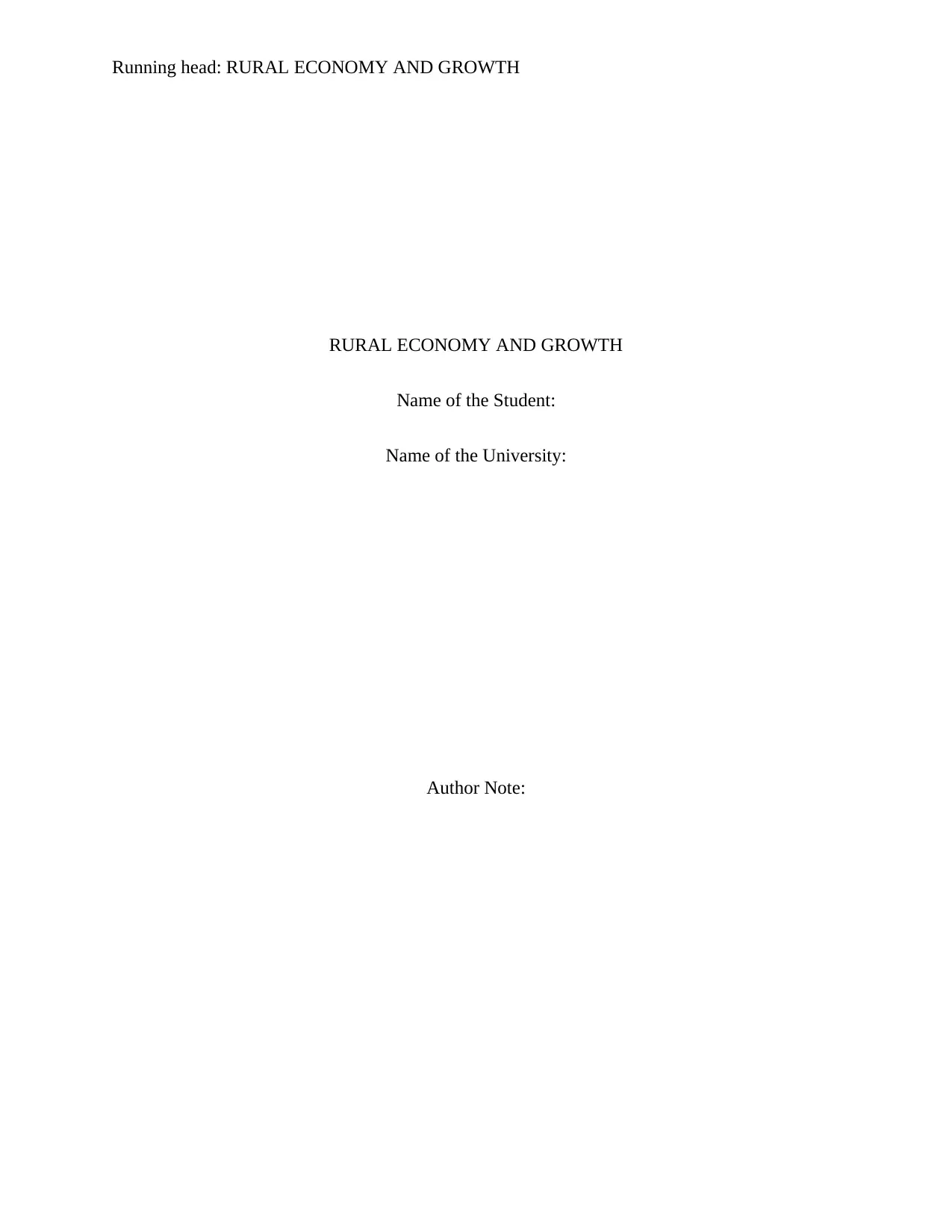
Running head: RURAL ECONOMY AND GROWTH
RURAL ECONOMY AND GROWTH
Name of the Student:
Name of the University:
Author Note:
RURAL ECONOMY AND GROWTH
Name of the Student:
Name of the University:
Author Note:
Paraphrase This Document
Need a fresh take? Get an instant paraphrase of this document with our AI Paraphraser
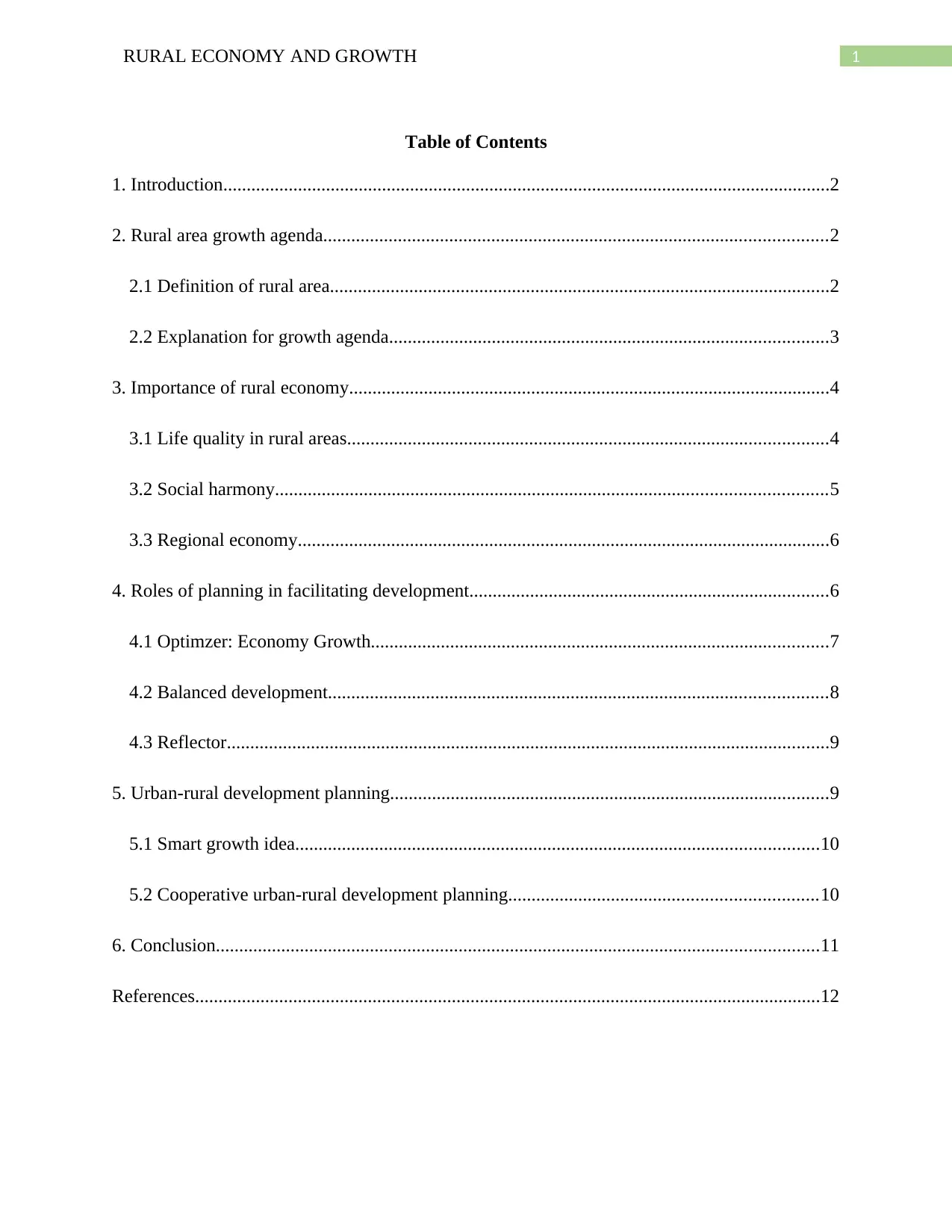
1RURAL ECONOMY AND GROWTH
Table of Contents
1. Introduction..................................................................................................................................2
2. Rural area growth agenda............................................................................................................2
2.1 Definition of rural area...........................................................................................................2
2.2 Explanation for growth agenda..............................................................................................3
3. Importance of rural economy.......................................................................................................4
3.1 Life quality in rural areas.......................................................................................................4
3.2 Social harmony......................................................................................................................5
3.3 Regional economy..................................................................................................................6
4. Roles of planning in facilitating development.............................................................................6
4.1 Optimzer: Economy Growth..................................................................................................7
4.2 Balanced development...........................................................................................................8
4.3 Reflector.................................................................................................................................9
5. Urban-rural development planning..............................................................................................9
5.1 Smart growth idea................................................................................................................10
5.2 Cooperative urban-rural development planning..................................................................10
6. Conclusion.................................................................................................................................11
References......................................................................................................................................12
Table of Contents
1. Introduction..................................................................................................................................2
2. Rural area growth agenda............................................................................................................2
2.1 Definition of rural area...........................................................................................................2
2.2 Explanation for growth agenda..............................................................................................3
3. Importance of rural economy.......................................................................................................4
3.1 Life quality in rural areas.......................................................................................................4
3.2 Social harmony......................................................................................................................5
3.3 Regional economy..................................................................................................................6
4. Roles of planning in facilitating development.............................................................................6
4.1 Optimzer: Economy Growth..................................................................................................7
4.2 Balanced development...........................................................................................................8
4.3 Reflector.................................................................................................................................9
5. Urban-rural development planning..............................................................................................9
5.1 Smart growth idea................................................................................................................10
5.2 Cooperative urban-rural development planning..................................................................10
6. Conclusion.................................................................................................................................11
References......................................................................................................................................12
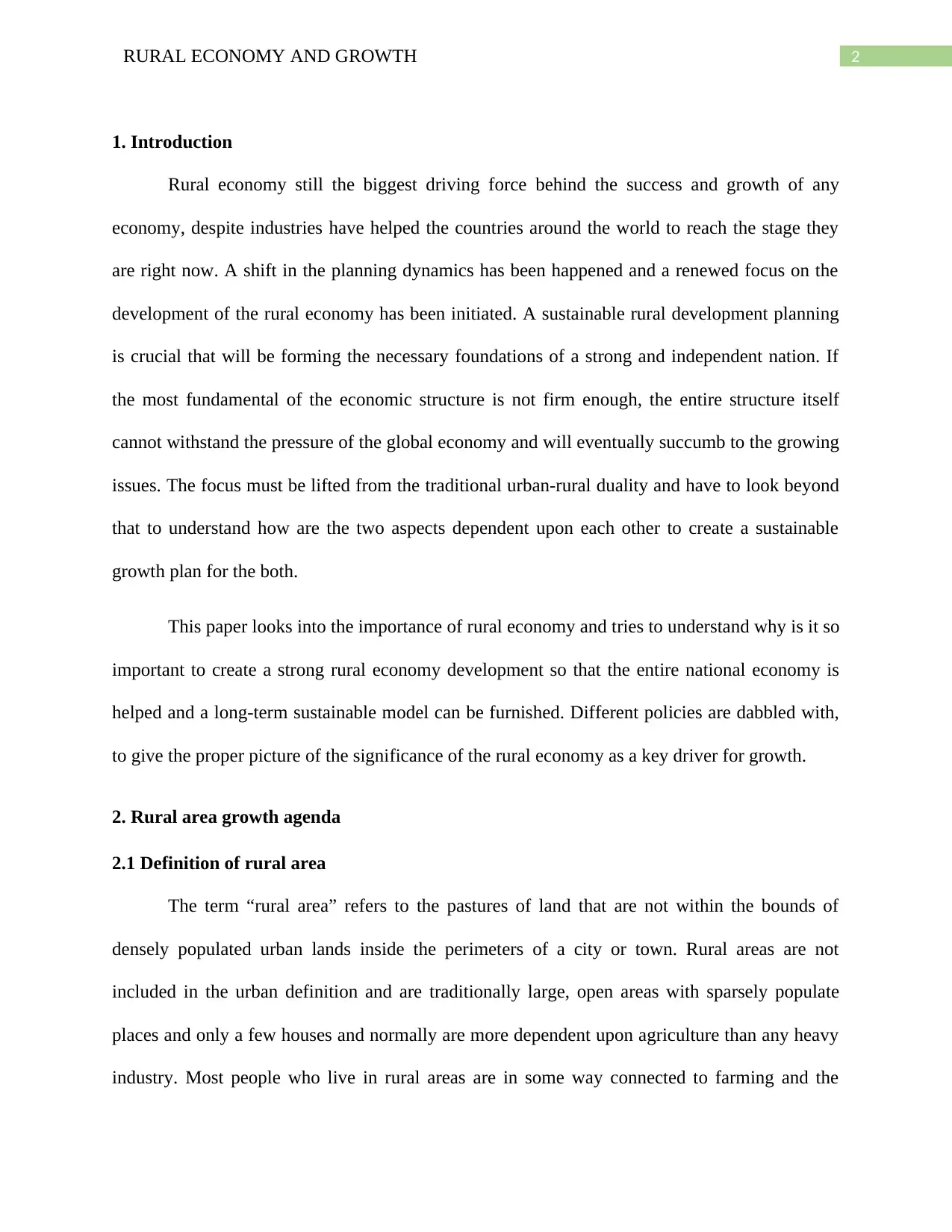
2RURAL ECONOMY AND GROWTH
1. Introduction
Rural economy still the biggest driving force behind the success and growth of any
economy, despite industries have helped the countries around the world to reach the stage they
are right now. A shift in the planning dynamics has been happened and a renewed focus on the
development of the rural economy has been initiated. A sustainable rural development planning
is crucial that will be forming the necessary foundations of a strong and independent nation. If
the most fundamental of the economic structure is not firm enough, the entire structure itself
cannot withstand the pressure of the global economy and will eventually succumb to the growing
issues. The focus must be lifted from the traditional urban-rural duality and have to look beyond
that to understand how are the two aspects dependent upon each other to create a sustainable
growth plan for the both.
This paper looks into the importance of rural economy and tries to understand why is it so
important to create a strong rural economy development so that the entire national economy is
helped and a long-term sustainable model can be furnished. Different policies are dabbled with,
to give the proper picture of the significance of the rural economy as a key driver for growth.
2. Rural area growth agenda
2.1 Definition of rural area
The term “rural area” refers to the pastures of land that are not within the bounds of
densely populated urban lands inside the perimeters of a city or town. Rural areas are not
included in the urban definition and are traditionally large, open areas with sparsely populate
places and only a few houses and normally are more dependent upon agriculture than any heavy
industry. Most people who live in rural areas are in some way connected to farming and the
1. Introduction
Rural economy still the biggest driving force behind the success and growth of any
economy, despite industries have helped the countries around the world to reach the stage they
are right now. A shift in the planning dynamics has been happened and a renewed focus on the
development of the rural economy has been initiated. A sustainable rural development planning
is crucial that will be forming the necessary foundations of a strong and independent nation. If
the most fundamental of the economic structure is not firm enough, the entire structure itself
cannot withstand the pressure of the global economy and will eventually succumb to the growing
issues. The focus must be lifted from the traditional urban-rural duality and have to look beyond
that to understand how are the two aspects dependent upon each other to create a sustainable
growth plan for the both.
This paper looks into the importance of rural economy and tries to understand why is it so
important to create a strong rural economy development so that the entire national economy is
helped and a long-term sustainable model can be furnished. Different policies are dabbled with,
to give the proper picture of the significance of the rural economy as a key driver for growth.
2. Rural area growth agenda
2.1 Definition of rural area
The term “rural area” refers to the pastures of land that are not within the bounds of
densely populated urban lands inside the perimeters of a city or town. Rural areas are not
included in the urban definition and are traditionally large, open areas with sparsely populate
places and only a few houses and normally are more dependent upon agriculture than any heavy
industry. Most people who live in rural areas are in some way connected to farming and the
⊘ This is a preview!⊘
Do you want full access?
Subscribe today to unlock all pages.

Trusted by 1+ million students worldwide
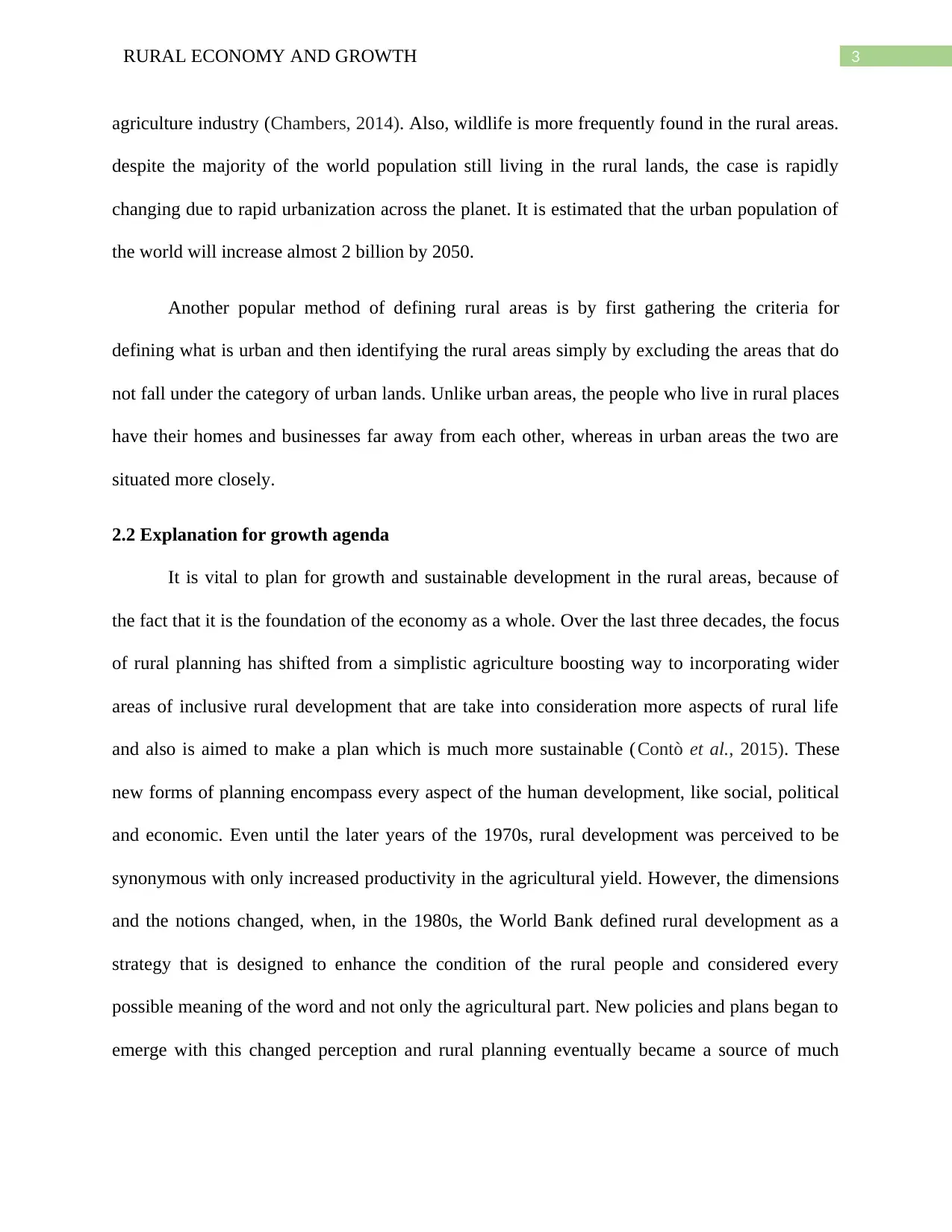
3RURAL ECONOMY AND GROWTH
agriculture industry (Chambers, 2014). Also, wildlife is more frequently found in the rural areas.
despite the majority of the world population still living in the rural lands, the case is rapidly
changing due to rapid urbanization across the planet. It is estimated that the urban population of
the world will increase almost 2 billion by 2050.
Another popular method of defining rural areas is by first gathering the criteria for
defining what is urban and then identifying the rural areas simply by excluding the areas that do
not fall under the category of urban lands. Unlike urban areas, the people who live in rural places
have their homes and businesses far away from each other, whereas in urban areas the two are
situated more closely.
2.2 Explanation for growth agenda
It is vital to plan for growth and sustainable development in the rural areas, because of
the fact that it is the foundation of the economy as a whole. Over the last three decades, the focus
of rural planning has shifted from a simplistic agriculture boosting way to incorporating wider
areas of inclusive rural development that are take into consideration more aspects of rural life
and also is aimed to make a plan which is much more sustainable (Contò et al., 2015). These
new forms of planning encompass every aspect of the human development, like social, political
and economic. Even until the later years of the 1970s, rural development was perceived to be
synonymous with only increased productivity in the agricultural yield. However, the dimensions
and the notions changed, when, in the 1980s, the World Bank defined rural development as a
strategy that is designed to enhance the condition of the rural people and considered every
possible meaning of the word and not only the agricultural part. New policies and plans began to
emerge with this changed perception and rural planning eventually became a source of much
agriculture industry (Chambers, 2014). Also, wildlife is more frequently found in the rural areas.
despite the majority of the world population still living in the rural lands, the case is rapidly
changing due to rapid urbanization across the planet. It is estimated that the urban population of
the world will increase almost 2 billion by 2050.
Another popular method of defining rural areas is by first gathering the criteria for
defining what is urban and then identifying the rural areas simply by excluding the areas that do
not fall under the category of urban lands. Unlike urban areas, the people who live in rural places
have their homes and businesses far away from each other, whereas in urban areas the two are
situated more closely.
2.2 Explanation for growth agenda
It is vital to plan for growth and sustainable development in the rural areas, because of
the fact that it is the foundation of the economy as a whole. Over the last three decades, the focus
of rural planning has shifted from a simplistic agriculture boosting way to incorporating wider
areas of inclusive rural development that are take into consideration more aspects of rural life
and also is aimed to make a plan which is much more sustainable (Contò et al., 2015). These
new forms of planning encompass every aspect of the human development, like social, political
and economic. Even until the later years of the 1970s, rural development was perceived to be
synonymous with only increased productivity in the agricultural yield. However, the dimensions
and the notions changed, when, in the 1980s, the World Bank defined rural development as a
strategy that is designed to enhance the condition of the rural people and considered every
possible meaning of the word and not only the agricultural part. New policies and plans began to
emerge with this changed perception and rural planning eventually became a source of much
Paraphrase This Document
Need a fresh take? Get an instant paraphrase of this document with our AI Paraphraser
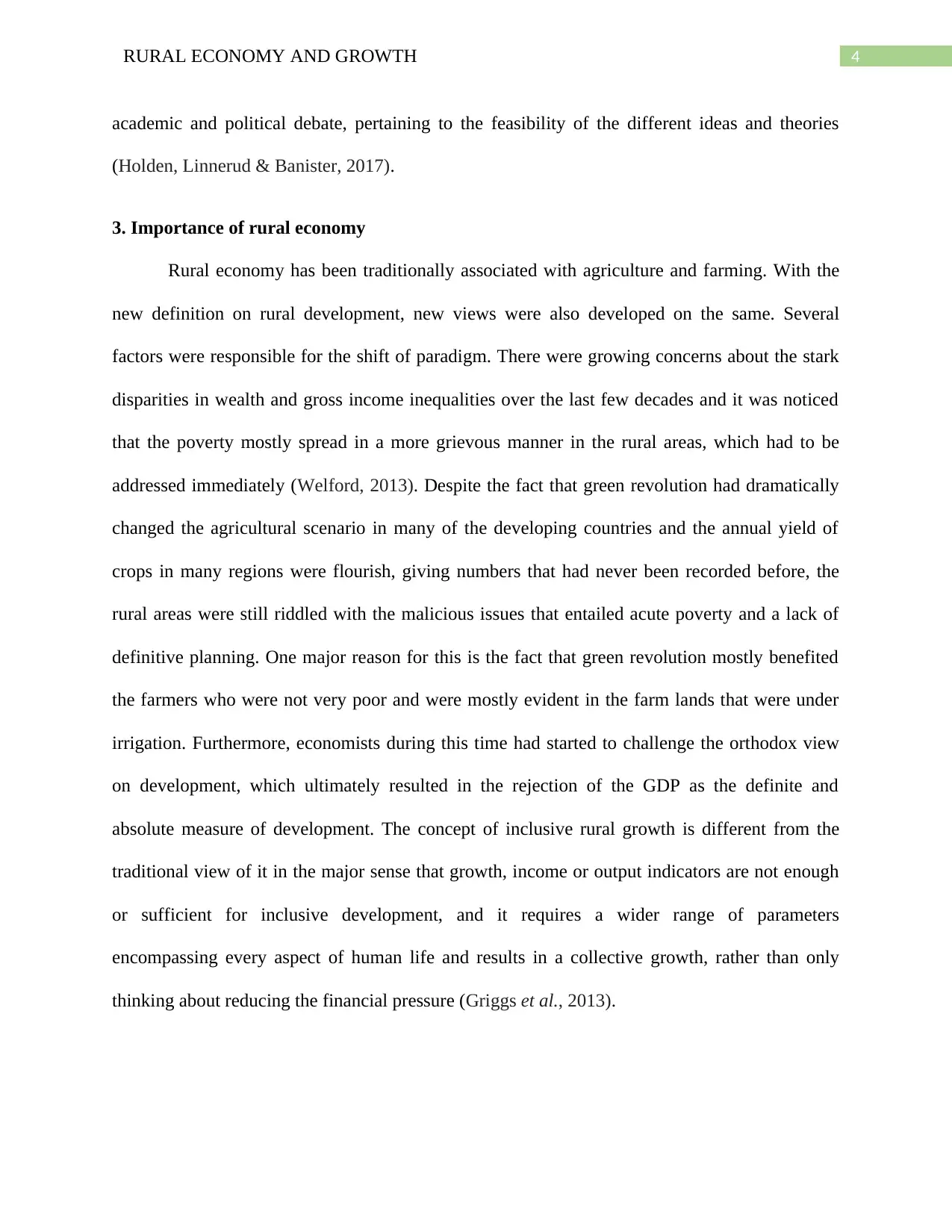
4RURAL ECONOMY AND GROWTH
academic and political debate, pertaining to the feasibility of the different ideas and theories
(Holden, Linnerud & Banister, 2017).
3. Importance of rural economy
Rural economy has been traditionally associated with agriculture and farming. With the
new definition on rural development, new views were also developed on the same. Several
factors were responsible for the shift of paradigm. There were growing concerns about the stark
disparities in wealth and gross income inequalities over the last few decades and it was noticed
that the poverty mostly spread in a more grievous manner in the rural areas, which had to be
addressed immediately (Welford, 2013). Despite the fact that green revolution had dramatically
changed the agricultural scenario in many of the developing countries and the annual yield of
crops in many regions were flourish, giving numbers that had never been recorded before, the
rural areas were still riddled with the malicious issues that entailed acute poverty and a lack of
definitive planning. One major reason for this is the fact that green revolution mostly benefited
the farmers who were not very poor and were mostly evident in the farm lands that were under
irrigation. Furthermore, economists during this time had started to challenge the orthodox view
on development, which ultimately resulted in the rejection of the GDP as the definite and
absolute measure of development. The concept of inclusive rural growth is different from the
traditional view of it in the major sense that growth, income or output indicators are not enough
or sufficient for inclusive development, and it requires a wider range of parameters
encompassing every aspect of human life and results in a collective growth, rather than only
thinking about reducing the financial pressure (Griggs et al., 2013).
academic and political debate, pertaining to the feasibility of the different ideas and theories
(Holden, Linnerud & Banister, 2017).
3. Importance of rural economy
Rural economy has been traditionally associated with agriculture and farming. With the
new definition on rural development, new views were also developed on the same. Several
factors were responsible for the shift of paradigm. There were growing concerns about the stark
disparities in wealth and gross income inequalities over the last few decades and it was noticed
that the poverty mostly spread in a more grievous manner in the rural areas, which had to be
addressed immediately (Welford, 2013). Despite the fact that green revolution had dramatically
changed the agricultural scenario in many of the developing countries and the annual yield of
crops in many regions were flourish, giving numbers that had never been recorded before, the
rural areas were still riddled with the malicious issues that entailed acute poverty and a lack of
definitive planning. One major reason for this is the fact that green revolution mostly benefited
the farmers who were not very poor and were mostly evident in the farm lands that were under
irrigation. Furthermore, economists during this time had started to challenge the orthodox view
on development, which ultimately resulted in the rejection of the GDP as the definite and
absolute measure of development. The concept of inclusive rural growth is different from the
traditional view of it in the major sense that growth, income or output indicators are not enough
or sufficient for inclusive development, and it requires a wider range of parameters
encompassing every aspect of human life and results in a collective growth, rather than only
thinking about reducing the financial pressure (Griggs et al., 2013).
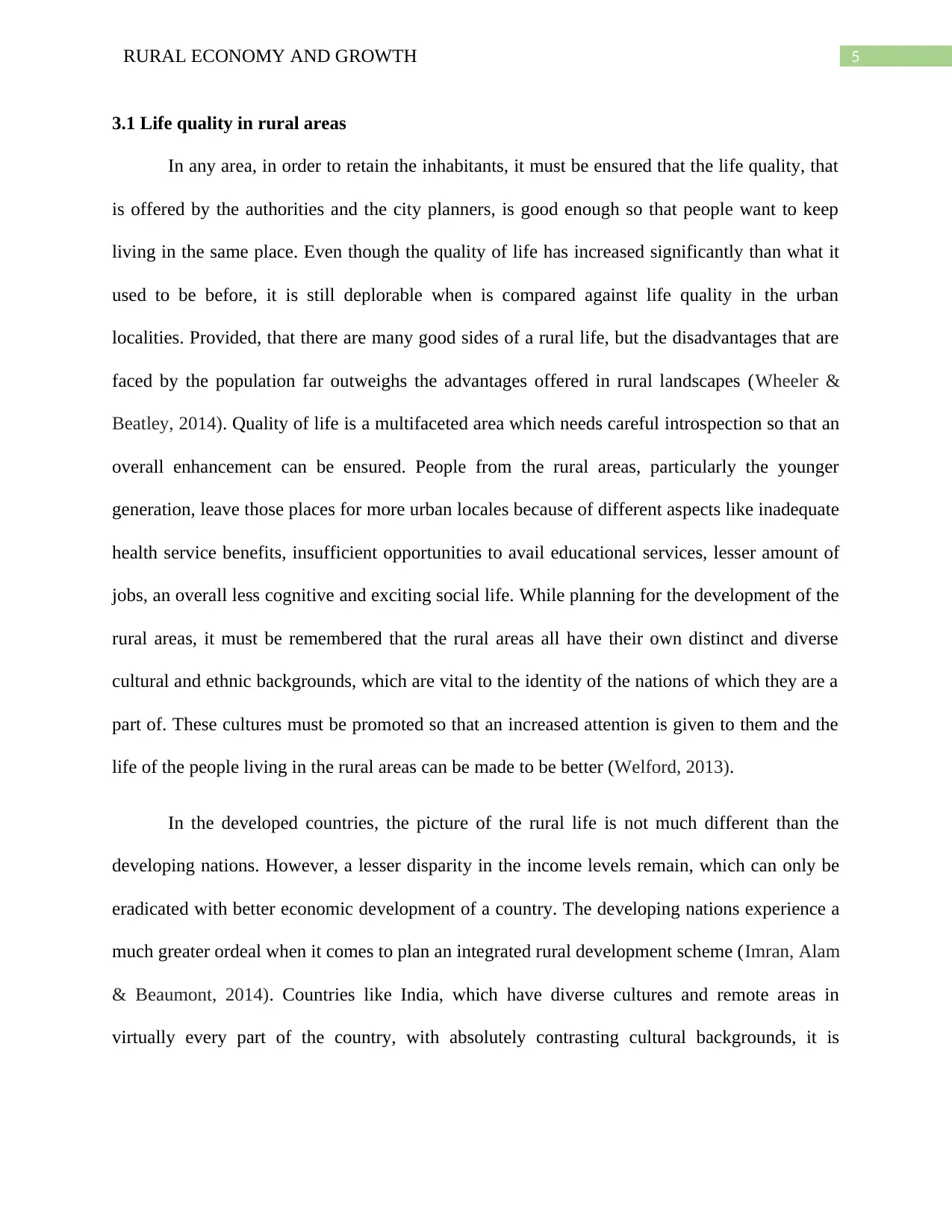
5RURAL ECONOMY AND GROWTH
3.1 Life quality in rural areas
In any area, in order to retain the inhabitants, it must be ensured that the life quality, that
is offered by the authorities and the city planners, is good enough so that people want to keep
living in the same place. Even though the quality of life has increased significantly than what it
used to be before, it is still deplorable when is compared against life quality in the urban
localities. Provided, that there are many good sides of a rural life, but the disadvantages that are
faced by the population far outweighs the advantages offered in rural landscapes (Wheeler &
Beatley, 2014). Quality of life is a multifaceted area which needs careful introspection so that an
overall enhancement can be ensured. People from the rural areas, particularly the younger
generation, leave those places for more urban locales because of different aspects like inadequate
health service benefits, insufficient opportunities to avail educational services, lesser amount of
jobs, an overall less cognitive and exciting social life. While planning for the development of the
rural areas, it must be remembered that the rural areas all have their own distinct and diverse
cultural and ethnic backgrounds, which are vital to the identity of the nations of which they are a
part of. These cultures must be promoted so that an increased attention is given to them and the
life of the people living in the rural areas can be made to be better (Welford, 2013).
In the developed countries, the picture of the rural life is not much different than the
developing nations. However, a lesser disparity in the income levels remain, which can only be
eradicated with better economic development of a country. The developing nations experience a
much greater ordeal when it comes to plan an integrated rural development scheme (Imran, Alam
& Beaumont, 2014). Countries like India, which have diverse cultures and remote areas in
virtually every part of the country, with absolutely contrasting cultural backgrounds, it is
3.1 Life quality in rural areas
In any area, in order to retain the inhabitants, it must be ensured that the life quality, that
is offered by the authorities and the city planners, is good enough so that people want to keep
living in the same place. Even though the quality of life has increased significantly than what it
used to be before, it is still deplorable when is compared against life quality in the urban
localities. Provided, that there are many good sides of a rural life, but the disadvantages that are
faced by the population far outweighs the advantages offered in rural landscapes (Wheeler &
Beatley, 2014). Quality of life is a multifaceted area which needs careful introspection so that an
overall enhancement can be ensured. People from the rural areas, particularly the younger
generation, leave those places for more urban locales because of different aspects like inadequate
health service benefits, insufficient opportunities to avail educational services, lesser amount of
jobs, an overall less cognitive and exciting social life. While planning for the development of the
rural areas, it must be remembered that the rural areas all have their own distinct and diverse
cultural and ethnic backgrounds, which are vital to the identity of the nations of which they are a
part of. These cultures must be promoted so that an increased attention is given to them and the
life of the people living in the rural areas can be made to be better (Welford, 2013).
In the developed countries, the picture of the rural life is not much different than the
developing nations. However, a lesser disparity in the income levels remain, which can only be
eradicated with better economic development of a country. The developing nations experience a
much greater ordeal when it comes to plan an integrated rural development scheme (Imran, Alam
& Beaumont, 2014). Countries like India, which have diverse cultures and remote areas in
virtually every part of the country, with absolutely contrasting cultural backgrounds, it is
⊘ This is a preview!⊘
Do you want full access?
Subscribe today to unlock all pages.

Trusted by 1+ million students worldwide
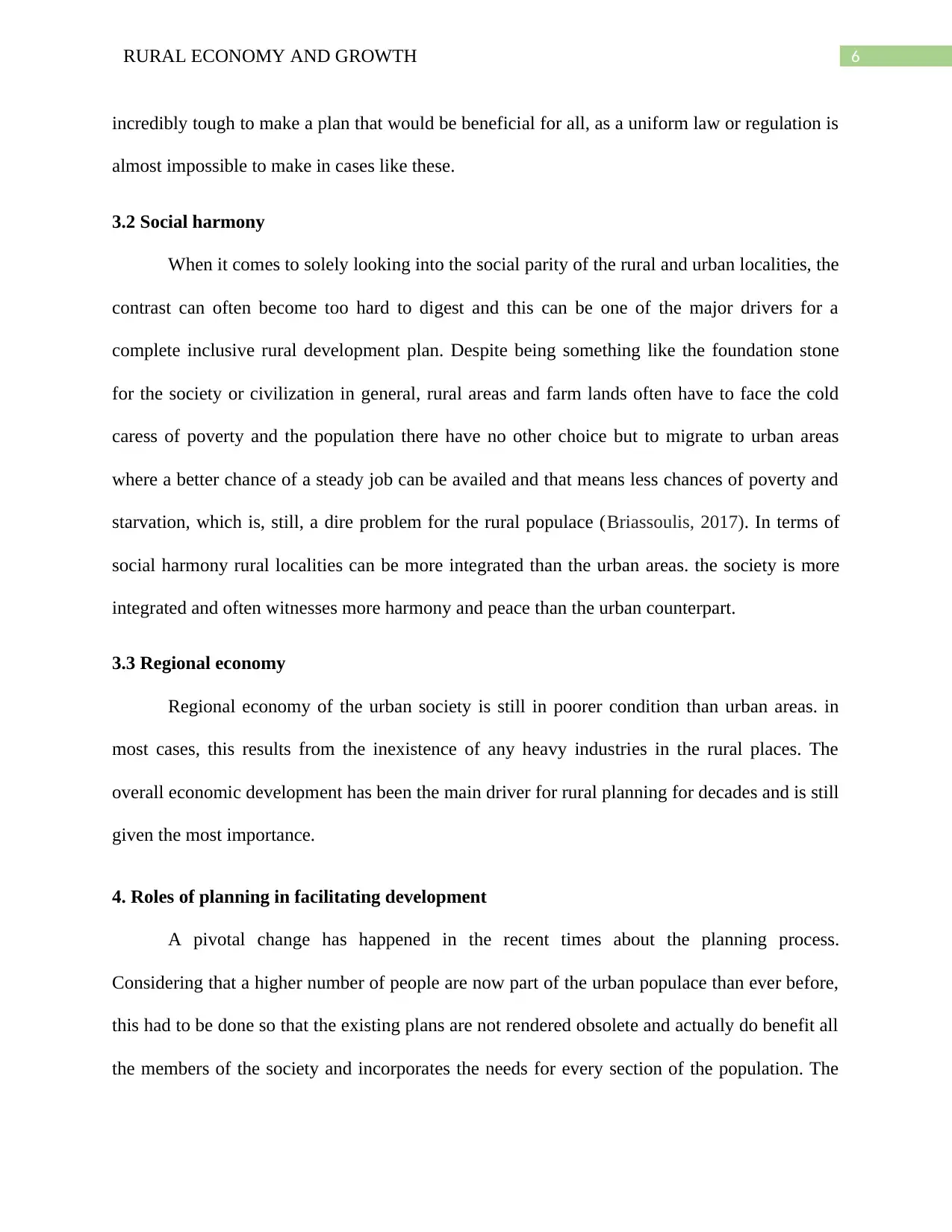
6RURAL ECONOMY AND GROWTH
incredibly tough to make a plan that would be beneficial for all, as a uniform law or regulation is
almost impossible to make in cases like these.
3.2 Social harmony
When it comes to solely looking into the social parity of the rural and urban localities, the
contrast can often become too hard to digest and this can be one of the major drivers for a
complete inclusive rural development plan. Despite being something like the foundation stone
for the society or civilization in general, rural areas and farm lands often have to face the cold
caress of poverty and the population there have no other choice but to migrate to urban areas
where a better chance of a steady job can be availed and that means less chances of poverty and
starvation, which is, still, a dire problem for the rural populace (Briassoulis, 2017). In terms of
social harmony rural localities can be more integrated than the urban areas. the society is more
integrated and often witnesses more harmony and peace than the urban counterpart.
3.3 Regional economy
Regional economy of the urban society is still in poorer condition than urban areas. in
most cases, this results from the inexistence of any heavy industries in the rural places. The
overall economic development has been the main driver for rural planning for decades and is still
given the most importance.
4. Roles of planning in facilitating development
A pivotal change has happened in the recent times about the planning process.
Considering that a higher number of people are now part of the urban populace than ever before,
this had to be done so that the existing plans are not rendered obsolete and actually do benefit all
the members of the society and incorporates the needs for every section of the population. The
incredibly tough to make a plan that would be beneficial for all, as a uniform law or regulation is
almost impossible to make in cases like these.
3.2 Social harmony
When it comes to solely looking into the social parity of the rural and urban localities, the
contrast can often become too hard to digest and this can be one of the major drivers for a
complete inclusive rural development plan. Despite being something like the foundation stone
for the society or civilization in general, rural areas and farm lands often have to face the cold
caress of poverty and the population there have no other choice but to migrate to urban areas
where a better chance of a steady job can be availed and that means less chances of poverty and
starvation, which is, still, a dire problem for the rural populace (Briassoulis, 2017). In terms of
social harmony rural localities can be more integrated than the urban areas. the society is more
integrated and often witnesses more harmony and peace than the urban counterpart.
3.3 Regional economy
Regional economy of the urban society is still in poorer condition than urban areas. in
most cases, this results from the inexistence of any heavy industries in the rural places. The
overall economic development has been the main driver for rural planning for decades and is still
given the most importance.
4. Roles of planning in facilitating development
A pivotal change has happened in the recent times about the planning process.
Considering that a higher number of people are now part of the urban populace than ever before,
this had to be done so that the existing plans are not rendered obsolete and actually do benefit all
the members of the society and incorporates the needs for every section of the population. The
Paraphrase This Document
Need a fresh take? Get an instant paraphrase of this document with our AI Paraphraser
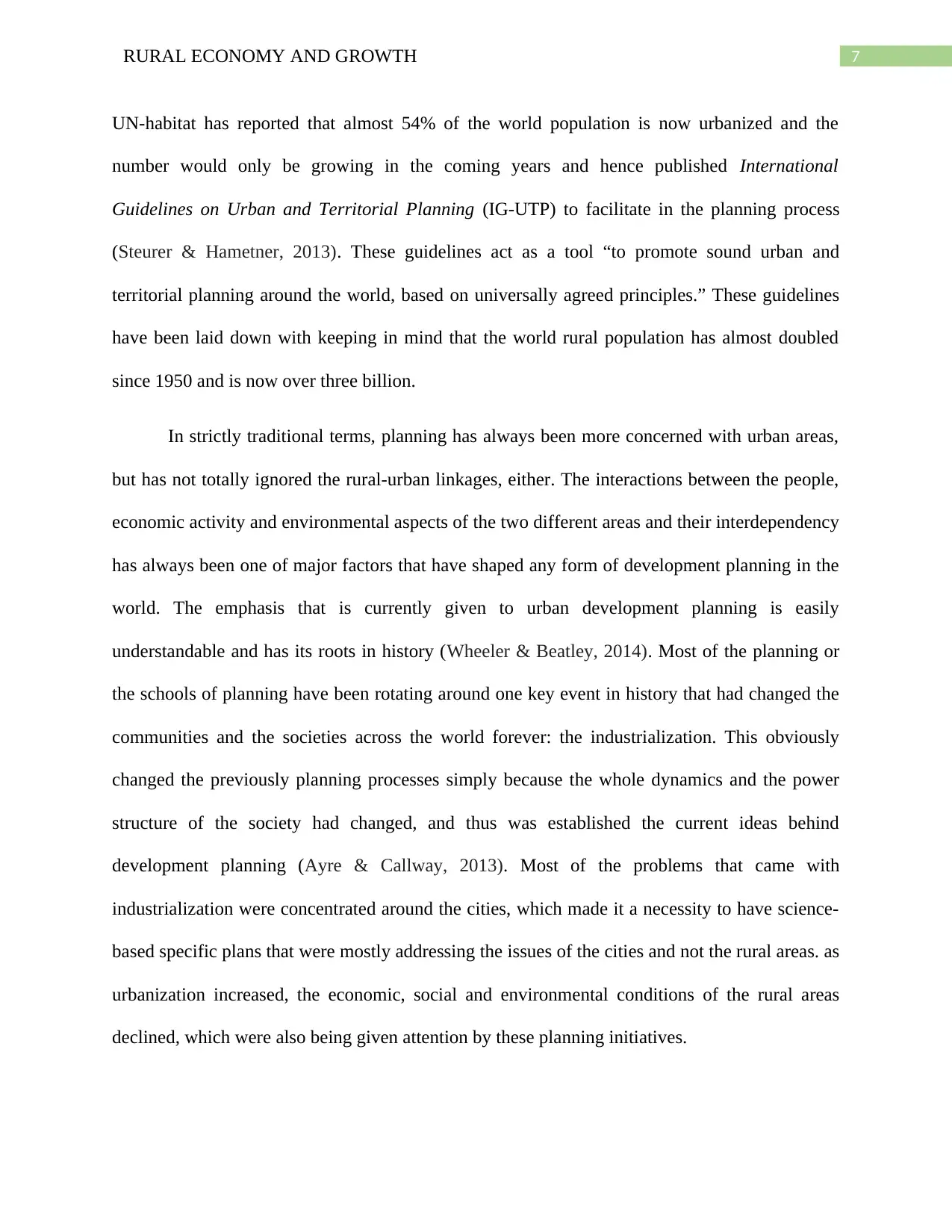
7RURAL ECONOMY AND GROWTH
UN-habitat has reported that almost 54% of the world population is now urbanized and the
number would only be growing in the coming years and hence published International
Guidelines on Urban and Territorial Planning (IG-UTP) to facilitate in the planning process
(Steurer & Hametner, 2013). These guidelines act as a tool “to promote sound urban and
territorial planning around the world, based on universally agreed principles.” These guidelines
have been laid down with keeping in mind that the world rural population has almost doubled
since 1950 and is now over three billion.
In strictly traditional terms, planning has always been more concerned with urban areas,
but has not totally ignored the rural-urban linkages, either. The interactions between the people,
economic activity and environmental aspects of the two different areas and their interdependency
has always been one of major factors that have shaped any form of development planning in the
world. The emphasis that is currently given to urban development planning is easily
understandable and has its roots in history (Wheeler & Beatley, 2014). Most of the planning or
the schools of planning have been rotating around one key event in history that had changed the
communities and the societies across the world forever: the industrialization. This obviously
changed the previously planning processes simply because the whole dynamics and the power
structure of the society had changed, and thus was established the current ideas behind
development planning (Ayre & Callway, 2013). Most of the problems that came with
industrialization were concentrated around the cities, which made it a necessity to have science-
based specific plans that were mostly addressing the issues of the cities and not the rural areas. as
urbanization increased, the economic, social and environmental conditions of the rural areas
declined, which were also being given attention by these planning initiatives.
UN-habitat has reported that almost 54% of the world population is now urbanized and the
number would only be growing in the coming years and hence published International
Guidelines on Urban and Territorial Planning (IG-UTP) to facilitate in the planning process
(Steurer & Hametner, 2013). These guidelines act as a tool “to promote sound urban and
territorial planning around the world, based on universally agreed principles.” These guidelines
have been laid down with keeping in mind that the world rural population has almost doubled
since 1950 and is now over three billion.
In strictly traditional terms, planning has always been more concerned with urban areas,
but has not totally ignored the rural-urban linkages, either. The interactions between the people,
economic activity and environmental aspects of the two different areas and their interdependency
has always been one of major factors that have shaped any form of development planning in the
world. The emphasis that is currently given to urban development planning is easily
understandable and has its roots in history (Wheeler & Beatley, 2014). Most of the planning or
the schools of planning have been rotating around one key event in history that had changed the
communities and the societies across the world forever: the industrialization. This obviously
changed the previously planning processes simply because the whole dynamics and the power
structure of the society had changed, and thus was established the current ideas behind
development planning (Ayre & Callway, 2013). Most of the problems that came with
industrialization were concentrated around the cities, which made it a necessity to have science-
based specific plans that were mostly addressing the issues of the cities and not the rural areas. as
urbanization increased, the economic, social and environmental conditions of the rural areas
declined, which were also being given attention by these planning initiatives.
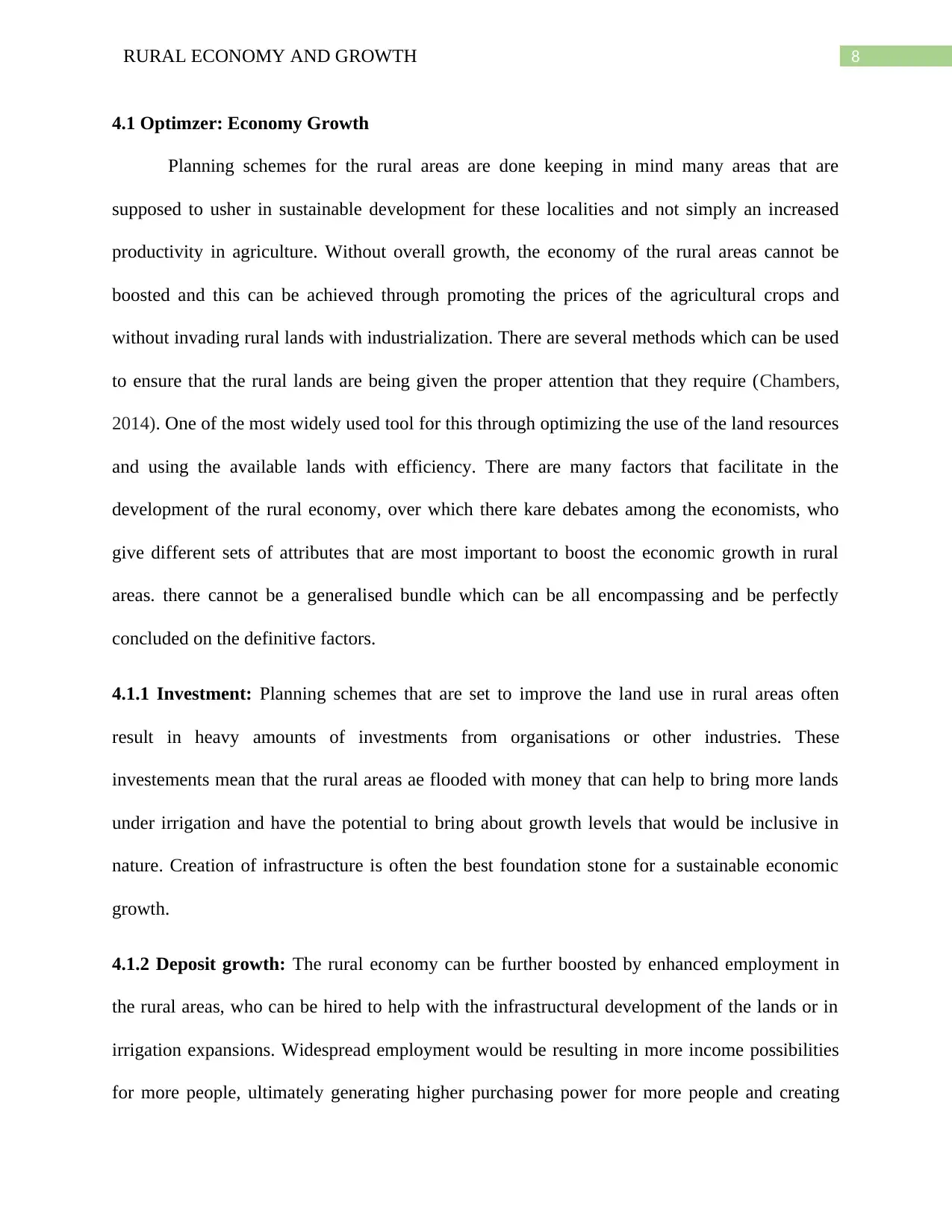
8RURAL ECONOMY AND GROWTH
4.1 Optimzer: Economy Growth
Planning schemes for the rural areas are done keeping in mind many areas that are
supposed to usher in sustainable development for these localities and not simply an increased
productivity in agriculture. Without overall growth, the economy of the rural areas cannot be
boosted and this can be achieved through promoting the prices of the agricultural crops and
without invading rural lands with industrialization. There are several methods which can be used
to ensure that the rural lands are being given the proper attention that they require (Chambers,
2014). One of the most widely used tool for this through optimizing the use of the land resources
and using the available lands with efficiency. There are many factors that facilitate in the
development of the rural economy, over which there kare debates among the economists, who
give different sets of attributes that are most important to boost the economic growth in rural
areas. there cannot be a generalised bundle which can be all encompassing and be perfectly
concluded on the definitive factors.
4.1.1 Investment: Planning schemes that are set to improve the land use in rural areas often
result in heavy amounts of investments from organisations or other industries. These
investements mean that the rural areas ae flooded with money that can help to bring more lands
under irrigation and have the potential to bring about growth levels that would be inclusive in
nature. Creation of infrastructure is often the best foundation stone for a sustainable economic
growth.
4.1.2 Deposit growth: The rural economy can be further boosted by enhanced employment in
the rural areas, who can be hired to help with the infrastructural development of the lands or in
irrigation expansions. Widespread employment would be resulting in more income possibilities
for more people, ultimately generating higher purchasing power for more people and creating
4.1 Optimzer: Economy Growth
Planning schemes for the rural areas are done keeping in mind many areas that are
supposed to usher in sustainable development for these localities and not simply an increased
productivity in agriculture. Without overall growth, the economy of the rural areas cannot be
boosted and this can be achieved through promoting the prices of the agricultural crops and
without invading rural lands with industrialization. There are several methods which can be used
to ensure that the rural lands are being given the proper attention that they require (Chambers,
2014). One of the most widely used tool for this through optimizing the use of the land resources
and using the available lands with efficiency. There are many factors that facilitate in the
development of the rural economy, over which there kare debates among the economists, who
give different sets of attributes that are most important to boost the economic growth in rural
areas. there cannot be a generalised bundle which can be all encompassing and be perfectly
concluded on the definitive factors.
4.1.1 Investment: Planning schemes that are set to improve the land use in rural areas often
result in heavy amounts of investments from organisations or other industries. These
investements mean that the rural areas ae flooded with money that can help to bring more lands
under irrigation and have the potential to bring about growth levels that would be inclusive in
nature. Creation of infrastructure is often the best foundation stone for a sustainable economic
growth.
4.1.2 Deposit growth: The rural economy can be further boosted by enhanced employment in
the rural areas, who can be hired to help with the infrastructural development of the lands or in
irrigation expansions. Widespread employment would be resulting in more income possibilities
for more people, ultimately generating higher purchasing power for more people and creating
⊘ This is a preview!⊘
Do you want full access?
Subscribe today to unlock all pages.

Trusted by 1+ million students worldwide
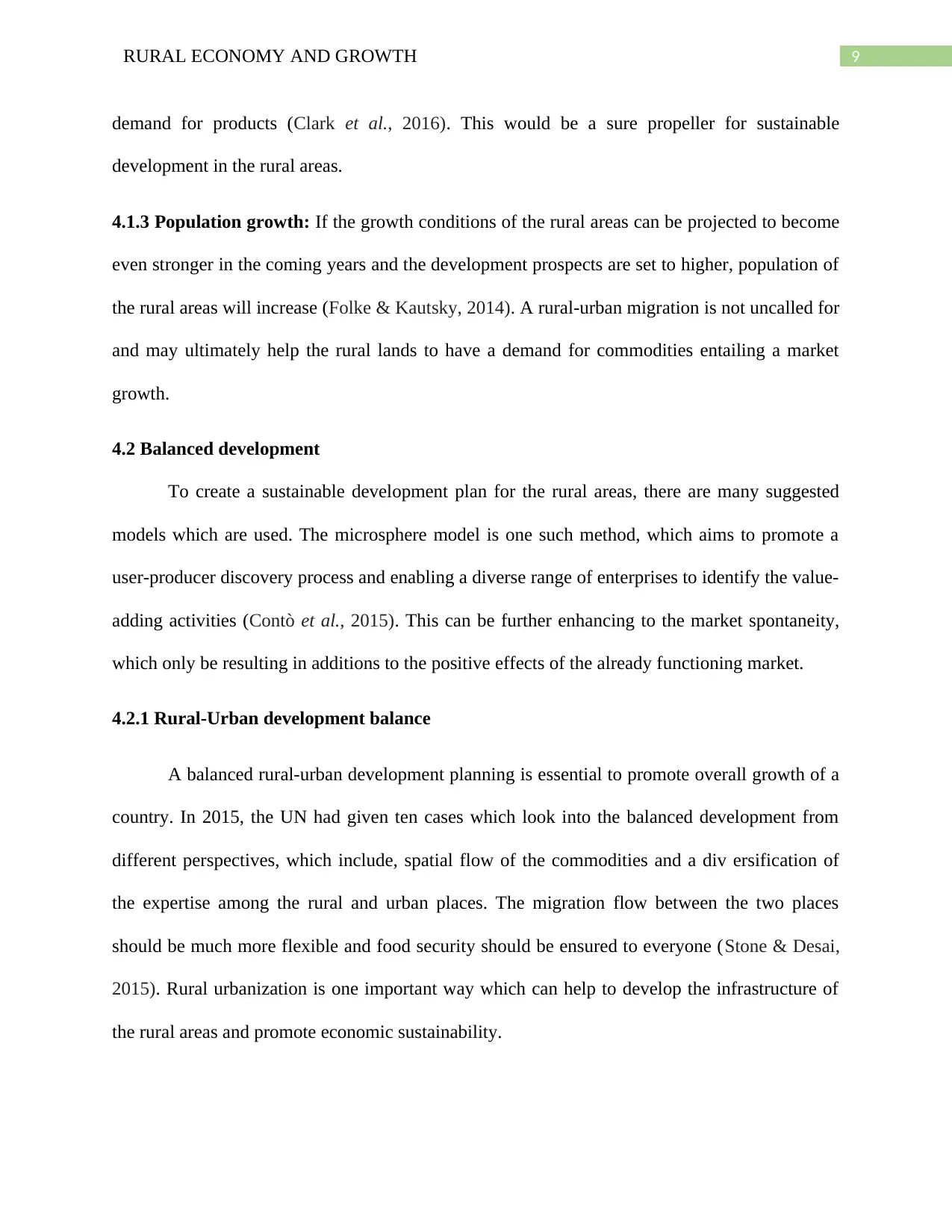
9RURAL ECONOMY AND GROWTH
demand for products (Clark et al., 2016). This would be a sure propeller for sustainable
development in the rural areas.
4.1.3 Population growth: If the growth conditions of the rural areas can be projected to become
even stronger in the coming years and the development prospects are set to higher, population of
the rural areas will increase (Folke & Kautsky, 2014). A rural-urban migration is not uncalled for
and may ultimately help the rural lands to have a demand for commodities entailing a market
growth.
4.2 Balanced development
To create a sustainable development plan for the rural areas, there are many suggested
models which are used. The microsphere model is one such method, which aims to promote a
user-producer discovery process and enabling a diverse range of enterprises to identify the value-
adding activities (Contò et al., 2015). This can be further enhancing to the market spontaneity,
which only be resulting in additions to the positive effects of the already functioning market.
4.2.1 Rural-Urban development balance
A balanced rural-urban development planning is essential to promote overall growth of a
country. In 2015, the UN had given ten cases which look into the balanced development from
different perspectives, which include, spatial flow of the commodities and a div ersification of
the expertise among the rural and urban places. The migration flow between the two places
should be much more flexible and food security should be ensured to everyone (Stone & Desai,
2015). Rural urbanization is one important way which can help to develop the infrastructure of
the rural areas and promote economic sustainability.
demand for products (Clark et al., 2016). This would be a sure propeller for sustainable
development in the rural areas.
4.1.3 Population growth: If the growth conditions of the rural areas can be projected to become
even stronger in the coming years and the development prospects are set to higher, population of
the rural areas will increase (Folke & Kautsky, 2014). A rural-urban migration is not uncalled for
and may ultimately help the rural lands to have a demand for commodities entailing a market
growth.
4.2 Balanced development
To create a sustainable development plan for the rural areas, there are many suggested
models which are used. The microsphere model is one such method, which aims to promote a
user-producer discovery process and enabling a diverse range of enterprises to identify the value-
adding activities (Contò et al., 2015). This can be further enhancing to the market spontaneity,
which only be resulting in additions to the positive effects of the already functioning market.
4.2.1 Rural-Urban development balance
A balanced rural-urban development planning is essential to promote overall growth of a
country. In 2015, the UN had given ten cases which look into the balanced development from
different perspectives, which include, spatial flow of the commodities and a div ersification of
the expertise among the rural and urban places. The migration flow between the two places
should be much more flexible and food security should be ensured to everyone (Stone & Desai,
2015). Rural urbanization is one important way which can help to develop the infrastructure of
the rural areas and promote economic sustainability.
Paraphrase This Document
Need a fresh take? Get an instant paraphrase of this document with our AI Paraphraser
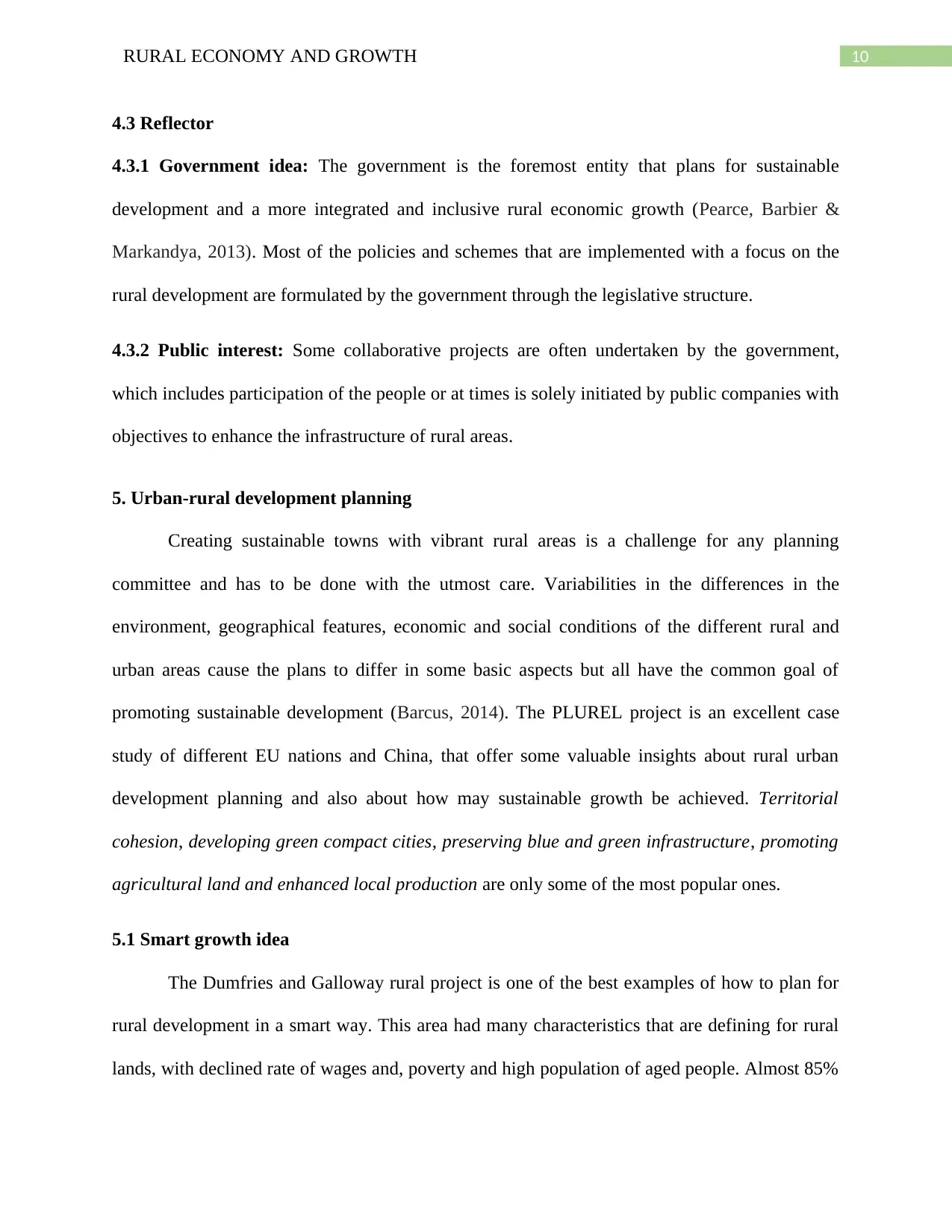
10RURAL ECONOMY AND GROWTH
4.3 Reflector
4.3.1 Government idea: The government is the foremost entity that plans for sustainable
development and a more integrated and inclusive rural economic growth (Pearce, Barbier &
Markandya, 2013). Most of the policies and schemes that are implemented with a focus on the
rural development are formulated by the government through the legislative structure.
4.3.2 Public interest: Some collaborative projects are often undertaken by the government,
which includes participation of the people or at times is solely initiated by public companies with
objectives to enhance the infrastructure of rural areas.
5. Urban-rural development planning
Creating sustainable towns with vibrant rural areas is a challenge for any planning
committee and has to be done with the utmost care. Variabilities in the differences in the
environment, geographical features, economic and social conditions of the different rural and
urban areas cause the plans to differ in some basic aspects but all have the common goal of
promoting sustainable development (Barcus, 2014). The PLUREL project is an excellent case
study of different EU nations and China, that offer some valuable insights about rural urban
development planning and also about how may sustainable growth be achieved. Territorial
cohesion, developing green compact cities, preserving blue and green infrastructure, promoting
agricultural land and enhanced local production are only some of the most popular ones.
5.1 Smart growth idea
The Dumfries and Galloway rural project is one of the best examples of how to plan for
rural development in a smart way. This area had many characteristics that are defining for rural
lands, with declined rate of wages and, poverty and high population of aged people. Almost 85%
4.3 Reflector
4.3.1 Government idea: The government is the foremost entity that plans for sustainable
development and a more integrated and inclusive rural economic growth (Pearce, Barbier &
Markandya, 2013). Most of the policies and schemes that are implemented with a focus on the
rural development are formulated by the government through the legislative structure.
4.3.2 Public interest: Some collaborative projects are often undertaken by the government,
which includes participation of the people or at times is solely initiated by public companies with
objectives to enhance the infrastructure of rural areas.
5. Urban-rural development planning
Creating sustainable towns with vibrant rural areas is a challenge for any planning
committee and has to be done with the utmost care. Variabilities in the differences in the
environment, geographical features, economic and social conditions of the different rural and
urban areas cause the plans to differ in some basic aspects but all have the common goal of
promoting sustainable development (Barcus, 2014). The PLUREL project is an excellent case
study of different EU nations and China, that offer some valuable insights about rural urban
development planning and also about how may sustainable growth be achieved. Territorial
cohesion, developing green compact cities, preserving blue and green infrastructure, promoting
agricultural land and enhanced local production are only some of the most popular ones.
5.1 Smart growth idea
The Dumfries and Galloway rural project is one of the best examples of how to plan for
rural development in a smart way. This area had many characteristics that are defining for rural
lands, with declined rate of wages and, poverty and high population of aged people. Almost 85%
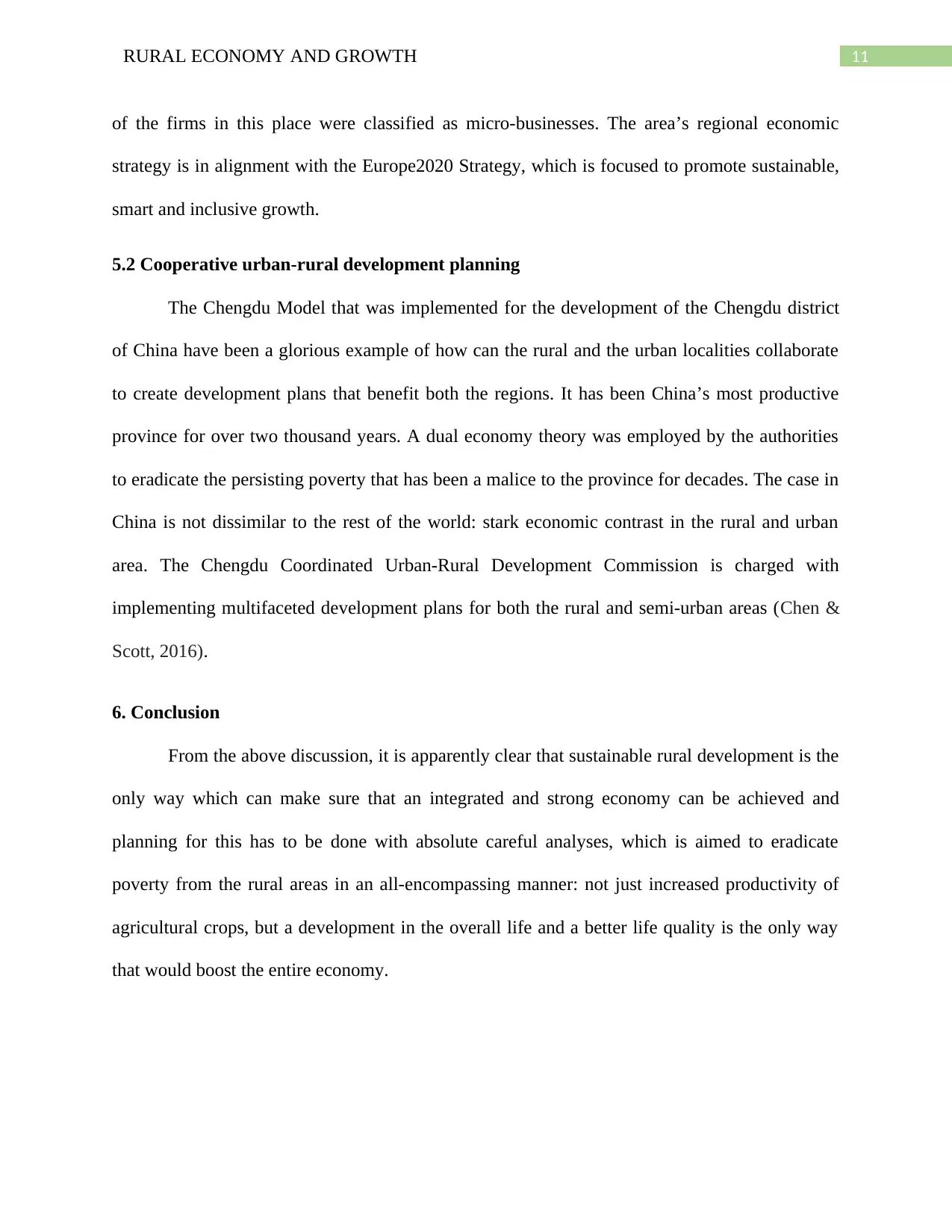
11RURAL ECONOMY AND GROWTH
of the firms in this place were classified as micro-businesses. The area’s regional economic
strategy is in alignment with the Europe2020 Strategy, which is focused to promote sustainable,
smart and inclusive growth.
5.2 Cooperative urban-rural development planning
The Chengdu Model that was implemented for the development of the Chengdu district
of China have been a glorious example of how can the rural and the urban localities collaborate
to create development plans that benefit both the regions. It has been China’s most productive
province for over two thousand years. A dual economy theory was employed by the authorities
to eradicate the persisting poverty that has been a malice to the province for decades. The case in
China is not dissimilar to the rest of the world: stark economic contrast in the rural and urban
area. The Chengdu Coordinated Urban-Rural Development Commission is charged with
implementing multifaceted development plans for both the rural and semi-urban areas (Chen &
Scott, 2016).
6. Conclusion
From the above discussion, it is apparently clear that sustainable rural development is the
only way which can make sure that an integrated and strong economy can be achieved and
planning for this has to be done with absolute careful analyses, which is aimed to eradicate
poverty from the rural areas in an all-encompassing manner: not just increased productivity of
agricultural crops, but a development in the overall life and a better life quality is the only way
that would boost the entire economy.
of the firms in this place were classified as micro-businesses. The area’s regional economic
strategy is in alignment with the Europe2020 Strategy, which is focused to promote sustainable,
smart and inclusive growth.
5.2 Cooperative urban-rural development planning
The Chengdu Model that was implemented for the development of the Chengdu district
of China have been a glorious example of how can the rural and the urban localities collaborate
to create development plans that benefit both the regions. It has been China’s most productive
province for over two thousand years. A dual economy theory was employed by the authorities
to eradicate the persisting poverty that has been a malice to the province for decades. The case in
China is not dissimilar to the rest of the world: stark economic contrast in the rural and urban
area. The Chengdu Coordinated Urban-Rural Development Commission is charged with
implementing multifaceted development plans for both the rural and semi-urban areas (Chen &
Scott, 2016).
6. Conclusion
From the above discussion, it is apparently clear that sustainable rural development is the
only way which can make sure that an integrated and strong economy can be achieved and
planning for this has to be done with absolute careful analyses, which is aimed to eradicate
poverty from the rural areas in an all-encompassing manner: not just increased productivity of
agricultural crops, but a development in the overall life and a better life quality is the only way
that would boost the entire economy.
⊘ This is a preview!⊘
Do you want full access?
Subscribe today to unlock all pages.

Trusted by 1+ million students worldwide
1 out of 14
Related Documents
Your All-in-One AI-Powered Toolkit for Academic Success.
+13062052269
info@desklib.com
Available 24*7 on WhatsApp / Email
![[object Object]](/_next/static/media/star-bottom.7253800d.svg)
Unlock your academic potential
Copyright © 2020–2025 A2Z Services. All Rights Reserved. Developed and managed by ZUCOL.





